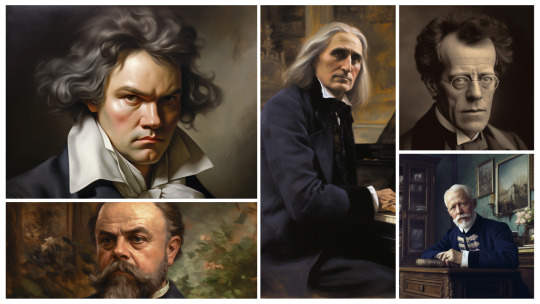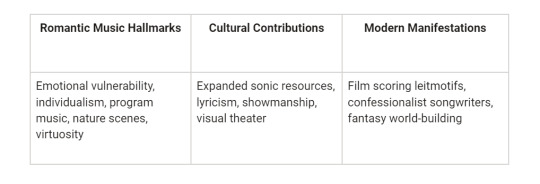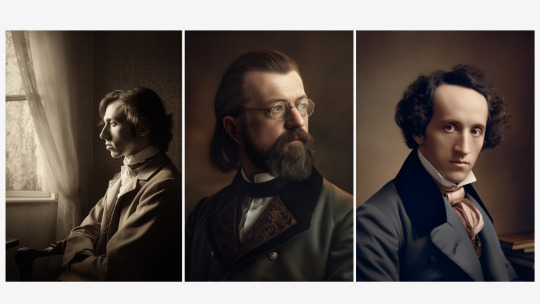#EmotionInMusic
Text
Impactful Even Today: The Cultural Legacy of Romantic Music

Romantic music’s monumental influence is still felt today. How innovations in lyricism, form, and virtuosity continue shaping cinematic scores, popular music, and fantastical audiovisual works. Timeless inspiration.
The Romantic period from circa 1800-1900 profoundly shaped classical music evolution and perceptions of emotional expression in sound. As innovators, Romantic composers asserted individualism while expanding sonic resources and poetic sensibilities. Their cultural legacy persists not just in enduring repertoire, but through continuous influence across entertainment. This article explores the lasting ripples stemming from musical Romanticism.

Defining Musical Romanticism
Romanticism across all art forms was a reaction against the rigid rational rules of the Enlightenment era. Music emphasized:
Individualism - Creative self-expression over conformity
Emotion - Music as a subjective reflection of feelings
Nature and the supernatural - Mystery, awe, spirituality
Composers manifested these concepts through lyricism, richer harmonies, and larger musical forms like program symphonies and music dramas. The era birthed beloved masterworks still embodying Romanticism today.
Core Tenets
Some core Romantic beliefs:
Imagination and emotion had cognitive value along with reason
The subjective experience took focus over objective absolutes
Individual liberty and originality should be cultivated
People should follow inner truth over societal expectations
There was redemptive power in beauty, creativity, love
These ideals took musical shape through pioneering new modes of intimate expression.
Emotionalism and Individualism
With ideals valuing imagination and inward experience, Romantic music became a vehicle for intimate personal statements. Composers crafted unique voices through:
Unfettered emotional vulnerability - Joy, despair, triumphs laid bare
Originality and experimentation with form, harmony, sonority
Freedom from rigid rules binding previous eras
Works aimed not just to impress, but impart the elusiveness and extremes of human feeling.
Audiences listened for authentic glimpses into creators’ minds through musical self-portraits. Notions of music explicitly representing the individual carry forward today.
Cult of the Solitary Artist
The archetype of the solitary tormented artist crafting works in isolation took hold. Composers wrote for self-understanding rather than society. They became revered as visionaries channeling truths beyond everyday experience.
The mythology surrounding the alienated, melancholy creative genius persists through figures like Kurt Cobain, Emily Dickinson, and Banksy. Romantic musical icons pioneered that imprint.
Literary and Visual Inspiration
Romantic composers sought to unite the emotional saturation of poetry, novels, art, and nature scenes with musical storytelling.
Program music referenced extramusical ideas through:
Storytelling titles - Evoking imagery, characters, and dramas
Literary motifs and musical themes unify a narrative
Sonically portraying the dynamic natural world or fantastical legends
Matching tonal colors and articulation choices to poetic verses
Listeners clung to these aural landscapes revealing the inner lives of beings real and imagined.
Background Influences
Societal developments enabled Romanticism, like:
Philosophy expounding individual rights
Fascination with wilderness and medieval tales
Gothic revival architecture signifies emotion
Literature exploring psychology and nature as mirror for principles
Composers absorbed these influences as creative inspiration.
Musical Depictions
Some typical Romantic musical motifs sought to reflect:
Mythic heroes, legends, folklore
The sea, mountains, and forests aligned to moods
Dreams, the psyche, spirituality
Medieval life, wars, fairytales
These remain touchstones for soundtracks and music-channeling narratives today.
Virtuosic Performers
The expanding expressive reach of instruments paralleled rising virtuoso performers pushing physical boundaries.
Audiences were magnetized by celebrity pianist-composers like Liszt and Paganini exhibiting sheer technical prowess matched by artistic sensitivity. A cult of personality around lauded interpreters emerged.
Traditions like the piano recital and concerto cadenza spotlighting bravura skills descend directly from the spectacle of Romantic performers. Projecting indomitable presence remains expected from concert soloists.
Performer Showcases
Romantic musicians had tailor-made forums for talent spectacle via:
Flamboyant piano recitals
Concerti featuring cadenzas
Chamber music emphasizes instruments equally
Arias showcasing vocal range and emotion
Opera staging becoming more elaborate
Technical mastery was celebrated rather than hidden.
Virtuoso Archetypes
The 19th-century virtuoso as creative genius archetype gets revived frequently through public figures like Jimi Hendrix, Michael Jackson, Serena Williams, and Johnny Weir known as much for talent and individuality as works produced.
Expanded Musical Resources
Romantic composers drastically expanded the sonic possibilities of instruments through:
Larger orchestras with added brass and exotic instruments
Piano building innovations extending range and resonance
Chromatic woodwinds like bass clarinet broadening instrumental color
Opera production similarly scaled up, incorporating:
Lush orchestration and amplified choruses
Theater technology enhancements like gas lighting
Intensified musical drama and psychological depth
These enlarged canvases of expression suited epic narratives with supernatural settings or existential scope beyond everyday life.
Piano Evolution
Rapidly evolving piano design advanced capabilities:
Metal bracing allows greater string tension and volume
Fully chromatic keyboards
Sustaining and soft pedals augment control
This expanded virtuosic possibilities as the piano became the ultimate Romantic instrument.
Opera Spectacle
Trends towards heightened theatricality included:
More historically accurate staging and costuming
Elaborate sets and special effects like electrical lighting innovations
Ballet interludes provide a spectacle
Larger choruses and orchestras wrapped around singers
Lasting Cultural Impact

While the Romantic period ended over a century ago, its musical legacy continuously reverberates through aspects of entertainment culture today.
Cinematic Music
Conventions of film scoring closely follow Romantic models, using:
Character leitmotifs - Musical cues attached to protagonists/ideas
Underscoring - Music influencing the perception of the unfolding drama
Expressing magic and wonder through swelling instrumental effects
This emotional enhancement of the story owes greatly to the Romantic playbook.
Lyrical Rock and Pop
The lyrical emphasis in genres like folk, rock ballads, and musical theater also build upon Romantic ideals of the piece reflecting some truth of internal life. Confessional singer-songwriters ruminating philosophically descend directly from the lineage of musical poetry established by Schubert, Schumann, and Brahms.
Fantastical World Building
In spectacles of fantasy Metal, prog rock, and even music videos, the immersed escapism into Nature's extremes, surreal dreamscapes, or mythological immensity channels the same Romantic poetic ideals through modern sound and vision.
These homages reveal that while the period faded, its spirit still compels artists towards utmost emotionality and imagination defying earthly bounds.
Conclusion
While the Romantic period transpired over a century ago, appreciating its pioneered musical innovations remains relevant. Core ideals reverberate through what music we create and consume today - fostering festival headliner god worship and bedroom poster daydreams far exceeding reality. Through maximizing music's emotional saturation and metaphoric reach, Romantic composers granted sound access.
Frequently Asked Questions
How did Romantic music differ from prior classical eras?
It emphasized individual creative freedom, intense emotions, and extra-musical inspiration from poetry/art/nature over rigid rules.
What lasting impacts did Romantic pianist-composers have?
They advanced piano technique and form while establishing the recital tradition showcasing virtuosity and personality.
How were larger orchestras and operatic productions developed in the Romantic period?
Orchestras grew through more brass, chromatic woodwinds, and divided strings. Operas became more theatrically immersive spectacles.
How do today’s movie soundtracks inherit from Romantic music?
Their emotional enhancement of unfolding drama through leitmotifs and atmospheric underscoring closely follow Romantic models.
What modern songwriting traditions descend from the Romantics?
Confessional lyrical styles emphasizing introspection and sonic scene setting continue the lineage of Schubert and Schumann’s musical poetry.
How do Romantic principles shape today's arts/entertainment?
Reverence for intense emotionality, imagination, and psychological vulnerability in artistic statements still compels creators today.
What lasting impacts did the Romantic musical ethos have?
It enshrined music composition and performance as conduits for intimate self-expression to channel profound facets of human experience.
#Romanticism#MusicalLegacy#ComposersWhoChangedCulture#EmotionInMusic#VirtuosityThenAndNow#StorytellingSounds#CinematicScores
0 notes